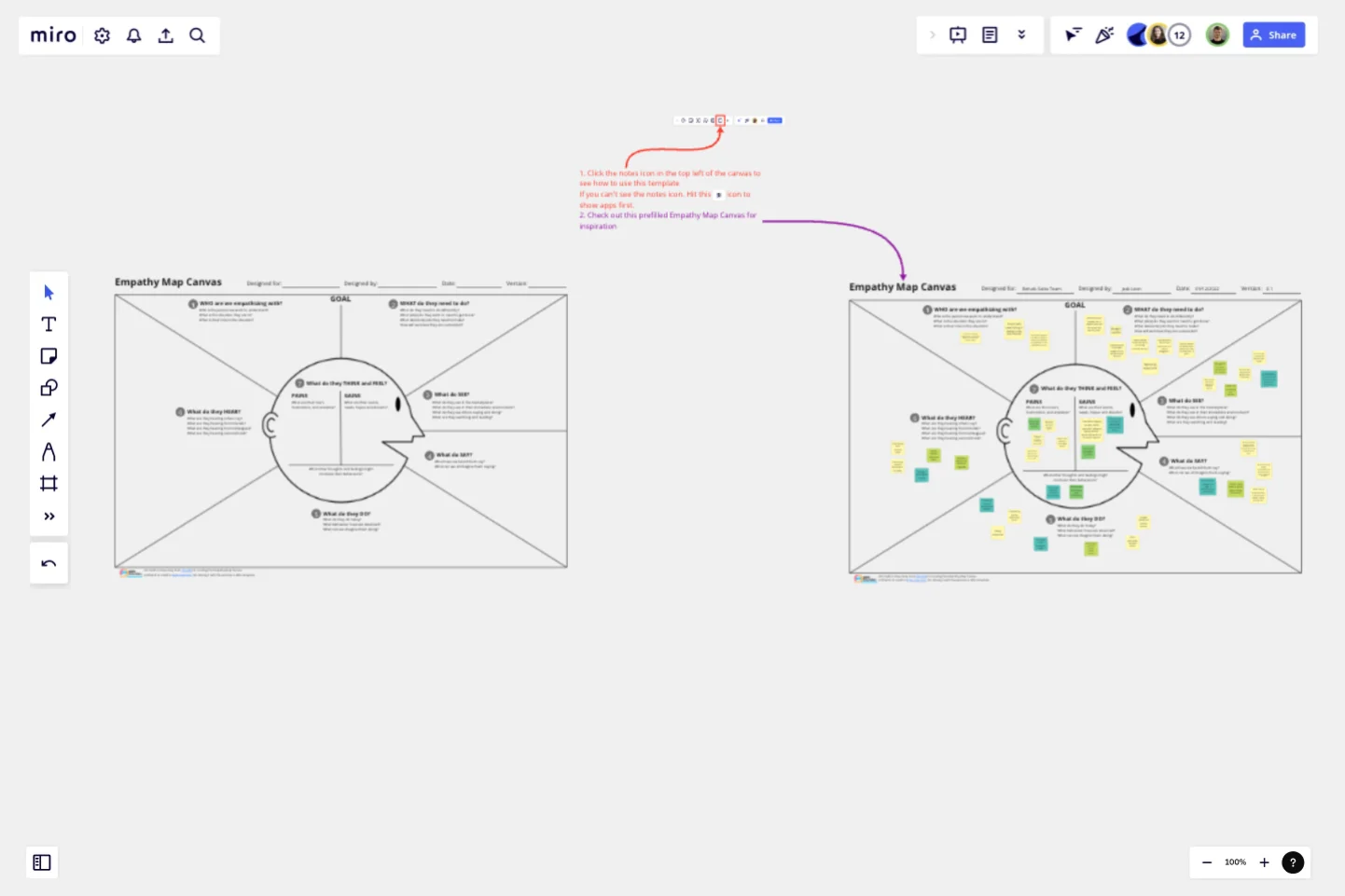Empathy Map Canvas by Jack León
The empathy map, developed by Dave Gray, founder of XPLANE, takes user personas to a whole new level. It puts you in the shoes of your users.
How to use the Empathy Map Canvas
This is best done in a collaborative environment with a cross-functional team and a variety of backgrounds. Frankly, it can be a little tiresome to do on your own, and you're likely to cut corners as a result 🙂 Ideally this exercise is facilitated by someone who has experience running workshops.
Step 1. The Goal
The Goal consists of 2 parts, numbered 1 and 2 on the canvas.Number 1, the description of a person representing your user, their role, and the specific situation that you are interested in helping with.Number 2, what they're trying to do. This is could be a part of a job, or a decision they need to make. It is important to articulate what success looks like for your user.This part is normally led by a Product Owner or a UX lead or analyst.Make sure everyone understands who the user is, what the user is trying to do, and the context within which the behavior is being performed.
Step 2. Around the Head
Now go around the outside of “The Big Head” following the numbers from 3 through to 6. Everyone grabs a bunch of sticky notes and joins in, trying to imagine the world from the user’s perspective.Everyone should spend around 5 minutes on each area; SEE, SAY, DO and HEAR. A great way to run this part of the exercise is using the working together alone technique. Everyone is given time to come up with their own ideas, followed by a quick tidy-up. The tidy-up phase is optional and might consist of a quick deduplication, a brief discussion if any notes are not clear, and sorting of the notes if relevant. Do this for each section from 2 to 6.
Step 3. Inside the Head
Now we are going inside the head of our user. Before you do, the facilitator should take 5 minutes to quickly summarise all the sticky notes in sections 1 through to 6. This will give everyone time to internalize and expand their empathy for the user.Section 7 has 3 areas, Pains, Gains, and others. As the canvas states, Pains are things that are worrying our user, Gains are things our user wants and others is an area to put notes which are hard to classify but feel important.Again, have the team work together alone, giving everyone 8-10 minutes on section 7. After that, the facilitator will optionally organize the sticky notes by deduplicating and sorting if required.
Conclusion
The exercise is now over, and the facilitator might decide to summarise and request clarification where notes are not clear.The Empathy Map Canvas is an indispensable part of Design Thinking, along with Persona Design and User Journey Mapping. Using these artifacts to shape proposition design ensures the team is developing customer-centric solutions.
This template was created by Jack León.
Get started with this template right now.
Empathy Mapping for Impact
Works best for:
Market Research, Research & Design
Empathy Mapping For Impact template is designed to help you capture and understand user experiences deeply. By focusing on what users think, feel, and do, you can create impactful and meaningful products. Perfect for UX designers and researchers.
Design Research Template
Works best for:
UX Design, Design Thinking, Desk Research
A design research map is a grid framework showing the relationship between two key intersections in research methodologies: mindset and approach. Design research maps encourage your team or clients to develop new business strategies using generative design thinking. Originally designed by academic Liz Sanders, the framework is meant to resolve confusion or overlap between research and design methods. Whether your team is in problem-solving or problem space definition mode, using a research design template can help you consider the collective value of many unrelated practices.
Journey Map To Plot the Customer Experience
Works best for:
Customer Journey Map
A journey is a tool to map out the customer experience of (a part of) your product/service in a visual way.
User Empathy Map
Works best for:
Market Research, Research & Design
User Empathy Map template helps you visualize user experiences and needs. It’s an essential tool for teams looking to design products that resonate with their users. Use this template to build empathy and improve user satisfaction.
Service Experience Observation Sheet
Works best for:
Research & Design
The Expanded Service Blueprint provides a detailed view of your service processes and interactions. This template is ideal for comprehensive service analysis and improvement. Use it to align teams, visualize the customer journey, and identify opportunities for optimization. It's perfect for enhancing service delivery, fostering collaboration, and ensuring a seamless and efficient service experience for your customers.
Practical Customer Journey Mapping by Alex Gilev
Works best for:
Customer Journey Map
Today, customers hold companies to high standards for product quality and user experience.
